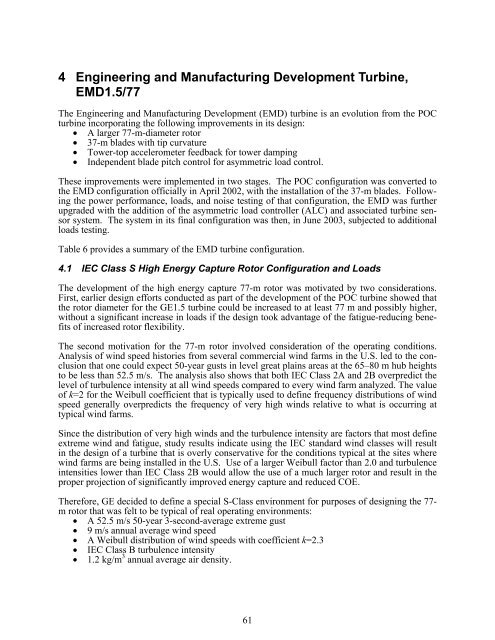Advanced Wind Turbine Program Next Generation Turbine ... - NREL
Advanced Wind Turbine Program Next Generation Turbine ... - NREL
Advanced Wind Turbine Program Next Generation Turbine ... - NREL
You also want an ePaper? Increase the reach of your titles
YUMPU automatically turns print PDFs into web optimized ePapers that Google loves.
4 Engineering and Manufacturing Development <strong>Turbine</strong>,<br />
EMD1.5/77<br />
The Engineering and Manufacturing Development (EMD) turbine is an evolution from the POC<br />
turbine incorporating the following improvements in its design:<br />
• A larger 77-m-diameter rotor<br />
• 37-m blades with tip curvature<br />
• Tower-top accelerometer feedback for tower damping<br />
• Independent blade pitch control for asymmetric load control.<br />
These improvements were implemented in two stages. The POC configuration was converted to<br />
the EMD configuration officially in April 2002, with the installation of the 37-m blades. Following<br />
the power performance, loads, and noise testing of that configuration, the EMD was further<br />
upgraded with the addition of the asymmetric load controller (ALC) and associated turbine sensor<br />
system. The system in its final configuration was then, in June 2003, subjected to additional<br />
loads testing.<br />
Table 6 provides a summary of the EMD turbine configuration.<br />
4.1 IEC Class S High Energy Capture Rotor Configuration and Loads<br />
The development of the high energy capture 77-m rotor was motivated by two considerations.<br />
First, earlier design efforts conducted as part of the development of the POC turbine showed that<br />
the rotor diameter for the GE1.5 turbine could be increased to at least 77 m and possibly higher,<br />
without a significant increase in loads if the design took advantage of the fatigue-reducing benefits<br />
of increased rotor flexibility.<br />
The second motivation for the 77-m rotor involved consideration of the operating conditions.<br />
Analysis of wind speed histories from several commercial wind farms in the U.S. led to the conclusion<br />
that one could expect 50-year gusts in level great plains areas at the 65–80 m hub heights<br />
to be less than 52.5 m/s. The analysis also shows that both IEC Class 2A and 2B overpredict the<br />
level of turbulence intensity at all wind speeds compared to every wind farm analyzed. The value<br />
of k=2 for the Weibull coefficient that is typically used to define frequency distributions of wind<br />
speed generally overpredicts the frequency of very high winds relative to what is occurring at<br />
typical wind farms.<br />
Since the distribution of very high winds and the turbulence intensity are factors that most define<br />
extreme wind and fatigue, study results indicate using the IEC standard wind classes will result<br />
in the design of a turbine that is overly conservative for the conditions typical at the sites where<br />
wind farms are being installed in the U.S. Use of a larger Weibull factor than 2.0 and turbulence<br />
intensities lower than IEC Class 2B would allow the use of a much larger rotor and result in the<br />
proper projection of significantly improved energy capture and reduced COE.<br />
Therefore, GE decided to define a special S-Class environment for purposes of designing the 77m<br />
rotor that was felt to be typical of real operating environments:<br />
• A 52.5 m/s 50-year 3-second-average extreme gust<br />
• 9 m/s annual average wind speed<br />
• A Weibull distribution of wind speeds with coefficient k=2.3<br />
• IEC Class B turbulence intensity<br />
• 1.2 kg/m 3 annual average air density.<br />
61
















